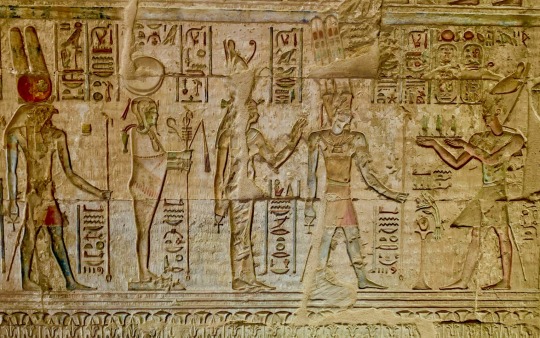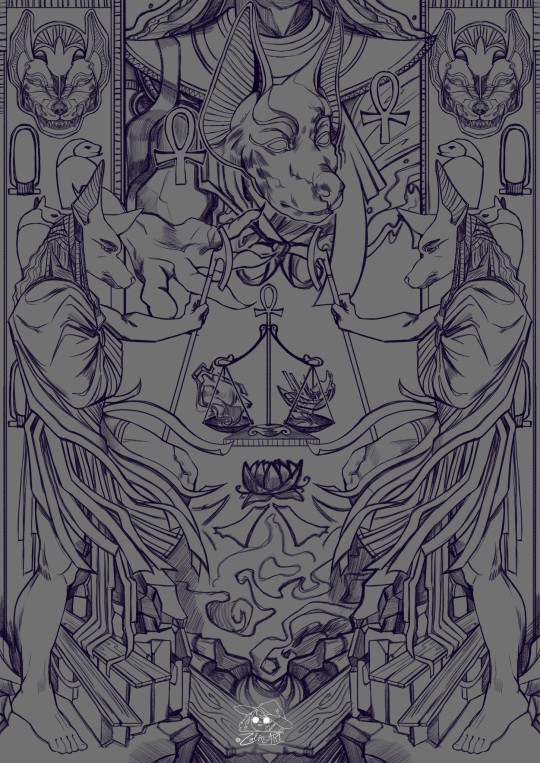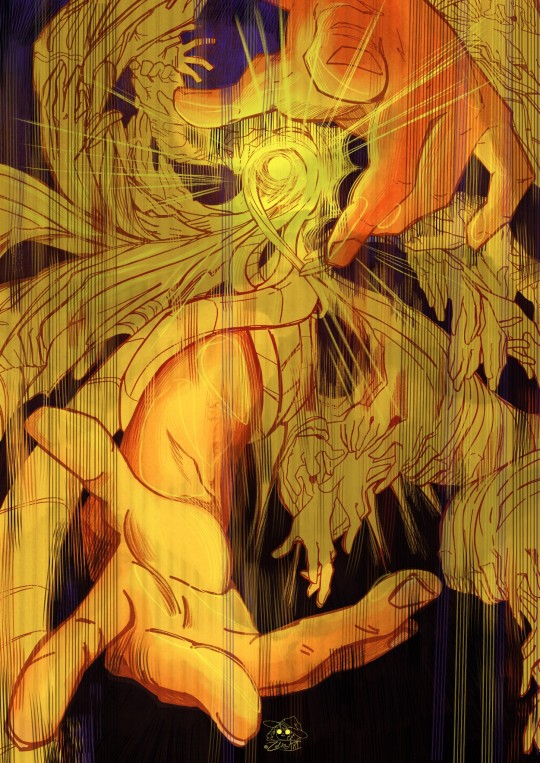#amun
Explore tagged Tumblr posts
Photo

Ancient Egypt
Egypt is a country in North Africa, on the Mediterranean Sea, and is home to one of the oldest civilizations on earth. The name 'Egypt' comes from the Greek Aegyptos which was the Greek pronunciation of the Ancient Egyptian name 'Hwt-Ka-Ptah' ("Mansion of the Spirit of Ptah"), originally the name of the city of Memphis.
Memphis was the first capital of Egypt and a famous religious and trade center; its high status is attested to by the Greeks alluding to the entire country by that name. To the ancient Egyptians themselves, their country was simply known as Kemet, which means 'Black Land', so named for the rich, dark soil along the Nile River where the first settlements began. Later, the country was known as Misr which means 'country', a name still in use by Egyptians for their nation in the present day. Egypt thrived for thousands of years (from c. 8000 BCE to c. 30 BCE) as an independent nation whose culture was famous for great cultural advances in every area of human knowledge, from the arts to science to technology and religion. The great monuments which ancient Egypt is still celebrated for reflect the depth and grandeur of Egyptian culture which influenced so many ancient civilizations, among them Greece and Rome.
One of the reasons for the enduring popularity of Egyptian culture is its emphasis on the grandeur of the human experience. Their great monuments, tombs, temples, and artwork all celebrate life and stand as reminders of what once was and what human beings, at their best, are capable of achieving. Although ancient Egypt in popular culture is often associated with death and mortuary rites, something even in these speaks to people across the ages of what it means to be a human being and the power and purpose of remembrance.
To the Egyptians, life on earth was only one aspect of an eternal journey. The soul was immortal and was only inhabiting a body on this physical plane for a short time. At death, one would meet with judgment in the Hall of Truth and, if justified, would move on to an eternal paradise known as The Field of Reeds which was a mirror image of one's life on earth. Once one had reached paradise one could live peacefully in the company of those one had loved while on earth, including one's pets, in the same neighborhood by the same stream, beneath the very same trees one thought had been lost at death. This eternal life, however, was only available to those who had lived well and in accordance with the will of the gods in the most perfect place conducive to such a goal: the land of Egypt.
Egypt has a long history which goes back far beyond the written word, the stories of the gods, or the monuments which have made the culture famous. Evidence of overgrazing of cattle, on the land which is now the Sahara Desert, has been dated to about 8000 BCE. This evidence, along with artifacts discovered, points to a thriving agricultural civilization in the region at that time. As the land was mostly arid even then, hunter-gatherer nomads sought the cool of the water source of the Nile River Valley and began to settle there sometime prior to 6000 BCE.
Organized farming began in the region c. 6000 BCE and communities known as the Badarian Culture began to flourish alongside the river. Industry developed at about this same time as evidenced by faience workshops discovered at Abydos dating to c. 5500 BCE. The Badarian were followed by the Amratian, the Gerzean, and the Naqada cultures (also known as Naqada I, Naqada II, and Naqada III), all of which contributed significantly to the development of what became Egyptian civilization. The written history of the land begins at some point between 3400 and 3200 BCE when hieroglyphic script is developed by the Naqada Culture III. By 3500 BCE mummification of the dead was in practice at the city of Hierakonpolis and large stone tombs built at Abydos. The city of Xois is recorded as being already ancient by 3100-2181 BCE as inscribed on the famous Palermo Stone. As in other cultures worldwide, the small agrarian communities became centralized and grew into larger urban centers.
Early History of Egypt
The Early Dynastic Period in Egypt (c. 3150 - c. 2613 BCE) saw the unification of the north and south kingdoms under the king Menes (also known as Meni or Manes) of Upper Egypt who conquered Lower Egypt in c. 3118 BCE or c. 3150 BCE. This version of the early history comes from the Aegyptica (History of Egypt) by the ancient historian Manetho who lived in the 3rd century BCE under the Ptolemaic Dynasty (323-30 BCE). Although his chronology has been disputed by later historians, it is still regularly consulted on dynastic succession and the early history of ancient Egypt.
Manetho's work is the only source which cites Menes and the conquest, and it is now thought that the man referred to by Manetho as 'Menes' was the king Narmer who peacefully united Upper and Lower Egypt under one rule. Identification of Menes with Narmer is far from universally accepted, however, and Menes has been as credibly linked to the king Hor-Aha (c. 3100-3050 BCE) who succeeded him. An explanation for Menes' association with his predecessor and successor is that 'Menes' is an honorific title meaning "he who endures" and not a personal name and so could have been used to refer to more than one king. The claim that the land was unified by military campaign is also disputed as the famous Narmer Palette, depicting a military victory, is considered by some scholars to be royal propaganda. The country may have first been united peacefully, but this seems unlikely.
Geographical designation in ancient Egypt follows the direction of the Nile River and so Upper Egypt is the southern region and Lower Egypt the northern area closer to the Mediterranean Sea. Narmer ruled from the city of Heirakonopolis and then from Memphis and Abydos. Trade increased significantly under the rulers of the Early Dynastic Period in Egypt and elaborate mastaba tombs, precursors to the later pyramids, developed in Egyptian burial practices which included increasingly elaborate mummification techniques.
Continue reading...
33 notes
·
View notes
Text

Replica Cast Head of Zeus-Amun, Roman Period (about 100 CE), Liverpool World Museum
Zeus-Amun was a popular god in Ptolemaic and Roman Egypt. He is a combination of the Egyptian god Amun and the Greek god Zeus. He is usually shown with the ram's horns of Amun and the bearded face of Zeus. In 331 BCE Alexander the Great claimed he was told by an oracle that he was the son of Zeus-Amun.
#gods#head#zeus amun#archaeology#ancient living#ancient beliefs#history#deity#figure#ancient cultures#ancient crafts#metal#metalworking#zeus#amun#beliefs
469 notes
·
View notes
Text

He needed a face, figured I could share it u-u
Other deets:
cat person, has owned four. The last one is a stubborn tortoise calico named Patricia (carries around a locket with some of her fur)
"do you wanna see my collection of phoenix scales?" actually shows you phoenix scales, and occasionally varghest teeth ("they're so shiny!!")
knows the name of every mountain in the Free Marches
well informed on his children's whereabouts, yet he doesn't want to get involved in their lives
falls in and out of love very rapidly. Longest relationship he had was with Amun's mother (one month)
#dragon age#elves#ankh#amun#no name for now because there's a reveal lmao#ndo sta l'art tag#he's not a bad guy he's just a terrible dad#except when it comes to cats
84 notes
·
View notes
Text

Old sketches of Amun and Ptah
89 notes
·
View notes
Text
oc art dumpppp




bunch of smooches and a cuddle

see it's funny because he is also a busy idol
#my art#full art#sketch dump#my ocs#tadao#ryunosuke#taryun#ichigo#kyo#kyochi#keizer#amun#keimun#taiki#rokuro#kotoya#taikoturo#shouhei#nobu (as a cookie...)#nobuhei#ishindenshin#grimm parade#cheer4u
29 notes
·
View notes
Text
Dua Amun-Ra!
He who is the unseen and the seen
You rise as the golden one
Your warmth embraces me
You kiss me as the breeze
You create the land, none comes before you
Your majesty cannot be defeated
You fill my nose with the breath of life
You are the ruler of eternity
You drive out all evil
Your light strengthens me
Your presence fills me
I am overtaken with awe of you
#Naru writes#prayer#kemetic polytheism#kemetic#kemetic paganism#kemeticism#kemetism#kemetic fandom#Amun-Ra#Amun Ra#Amun#god amun#Ra#Re#kemetic prayer#pagan prayer#deity worship#polytheism
40 notes
·
View notes
Text

King Ptolemy makes offerings to the Theban triad: Amun, Mut and Khons, as well as the falcon-headed Montu.
56 notes
·
View notes
Text





Egyptian Gods; Amun-Amunet, Anubis, Aten, Bastet and Medjed
5 complete and still need 29 Illustrations to finish this serie, probably I'm gonna die before to finish it but I'm gonna find out in the middle of the road or sm
#digital art#digital drawing#ilustración digital#egyptian mythology#egyptian gods#ancient god#aten egyptian god#bastet#Anubis#Amun#amunet#medjed
82 notes
·
View notes
Text





#genshin impact#nahida#fanart#redesign#sumeru#genshin fanart#nabu malikata#king deshret#greater lord rukkhadevata#rukkhadevata#pushpavatika#al-ahmar#amun#buer
37 notes
·
View notes
Text

Kandake, kadake or kentake (Meroitic: 𐦲𐦷𐦲𐦡 kdke), often Latinised as Candace (Ancient Greek: Κανδάκη, Kandakē), was the Meroitic term for the sister of the king of Kush who, due to the matrilineal succession, would bear the next heir, making her a queen mother.

Pliny writes that the "Queen of the Ethiopians" bore the title Candace, and indicates that the Ethiopians had conquered ancient Syria and the Mediterranean.
In 25 BC the Kush kandake Amanirenas, as reported by Strabo, attacked the city of Syene, today's Aswan, in territory of the Roman Empire; Emperor Augustus destroyed the city of Napata in retaliation.
Cassius Dio wrote that Kandake's army advanced as far as the Elephantine in Egypt, but Petronius defeated them and took Napata, their capital, and other cities.
Four African queens were known to the Greco-Roman world as the "Candaces": Amanishakheto, Amanirenas, Nawidemak, and Malegereabar

Biblical usage
The Baptism of Queen Candace's Eunuch (c. 1625–30, attributed to Hendrick van Balen and Jan Brueghel the Younger)
In the New Testament, a treasury official of "Candace, queen of the Ethiopians", returning from a trip to Jerusalem, met with Philip the Evangelist:
Now an angel of the Lord said to Philip, "Rise and go toward the south to the road that goes down from Jerusalem to Gaza." This is a desert place. And he rose and went. And there was an Ethiopian, a eunuch, a court official of Candace, queen of the Ethiopians, who was in charge of all her treasure. He had come to Jerusalem to worship
He discussed with Philip the meaning of a perplexing passage from the Book of Isaiah. Philip explained the scripture to him and he was promptly baptised in some nearby water. The eunuch 'went on his way, rejoicing', and presumably therefore reported back on his conversion to the Kandake

Evidence outside of Nubia that shows additional links to Kushite's queenship concept are found in Ethiopia. Ethiopia has a long dynastic history claimed to be over three millennia from before 1000 BC to 1973, the year of the overthrow of the last Menelik emperor, Haile Selassie. The Ethiopian monarchy's official chronicle of dynastic succession descends from Menelik I includes six regnant queens referred to as Kandake. The following queens from the king list have "Kandake" added to their name:
Nicauta Kandake (r. 740–730 BCE)
Nikawla Kandake II (r. 342–332 BCE)
Akawsis Kandake III (r. 325–315 BCE)
Nikosis Kandake IV (r. 242–232 BCE)
Nicotnis Kandake V (r. 35–25 BCE)
Garsemot Kandake VI (r. 40–50 CE) – Allegedly the queen who ruled at the time of the Biblical story of the Ethiopian eunuch.
Twenty-one queens are recorded as sole regent in the kingdom of Ethiopia until the 9th century CE. The conquest of Meroe by the Axumite King Ezana may well provide the historical fiction for the Ethiopian dynastic claim to the Nubian Kandakes and their kings, as it was from this point onwards that the Axumites began calling themselves "Ethiopians", a Greco-Roman term previously used largely for the ancient Nubians. For example, Makeda, Queen of Sheba, in the Kebra Nagast, is also recognized as Candace or "Queen Mother".

Alexandrian legend
Jewellery of Kandake Amanishakheto, from her tomb
A legend in the Alexander romance claims that "Candace of Meroë" fought Alexander the Great. In fact, Alexander never attacked Nubia and never attempted to move further south than the oasis of Siwa in Egypt. The story is that when Alexander attempted to conquer her lands in 332 BC, she arranged her armies strategically to meet him and was present on a war elephant when he approached. Having assessed the strength of her armies, Alexander decided to withdraw from Nubia, heading to Egypt instead. Another story claims that Alexander and Candace had a romantic encounter.
These accounts originate from Alexander Romance by an unknown writer called Pseudo-Callisthenes, and the work is largely a fictionalized and grandiose account of Alexander's life. It is commonly quoted, but there seems to be no historical reference to this event from Alexander's time. The whole story of Alexander and Candace's encounter appears to be legendary.
John Malalas has mixed the Pseudo-Callisthenes material with other and wrote about the affair of Alexander with Kandake, adding that they got married. Malalas also wrote that Kandake was an Indian queen and Alexander met her during his Indian campaign

List of ruling kandakes
Pyramid of Amanitore in modern day Sudan
See also: List of monarchs of Kush
At least eleven kandakes also ruled in their own right as monarchs (i.e. queen regnants) of Kush:
Nahirqo (middle 2nd century BC)
An unknown queen regnant (end of the 2nd–first half of the 1st century BC)
Amanirenas (end of the 1st century BC–beginning of the 1st century AD)
Amanishakheto (early 1st century AD)
Shanakdakhete (first half of the 1st century AD)
Nawidemak (first half of the 1st century AD?)
Amanitore (middle 1st century AD)
Amanikhatashan (middle 2nd century AD?)
Amanikhalika (second half of the 2nd century AD)
Patrapeamani [de] (early 4th century)
Amanipilade (mid-4th century)
Based on the reading of a single inscription, some lists give two later kandakes named Maloqorebar (266–283 AD) and Lahideamani (306-314 AD). A recently discovered inscription corrects this earlier reading, however, showing that neither was a woman.

Archaeological sources
The Kandakes of Meroe were first described through the Greek geographer's Strabo account of the "one-eyed Candace" in 23 BCE in his encyclopedia Geographica. There are at least ten regnant Meroitic queens during the 500 years between 260 BCE and 320 CE, and at least six during the 140 periods between 60 BC and 80 AD. The iconographic portrayal of the Meroitic queens depicts them as women often alone and at the forefront of their stelae and sculptures and shown in regal women's clothing. Early depictions of Kushite queens typically do not have Egyptian elements making their appearance drastically different from their Kushite men and Egyptian counterparts. As seen in the Dream Stela of Tanawetamani, a large shawl was wrapped around the body with an additionally decorated cloak worn over the first; typically, a small tab-like element hanging below the hem touches the ground and has been interpreted as a little tail. The first association with this element of dress is with Tarharqo's mother during his coronation ceremony.
It was not until George Reisner excavated the royal cemeteries at El Kurru and Nuri that archaeological material became available to study the Kushite queenship. Additionally, a few royal tombs of Kushite women have been found at Meroe's cemetery and in Egypt at Abydos (Leahy 1994). At El Kurru, six pyramids belong to royal women of the 25th Dynasty and a pyramid for queen Qalhata of the Napatan period. At Nuri, the tombs of royal women are located on the west plateau with more inscriptional information available at the site, linking the roles that the kings' mothers played in succession and their importance during the Kushite dynasty.
The most important event that Kushite women participated in was kingship's ensured continuity, where royal women were mentioned and represented in the royal ceremony. The lunettes of the stelae of Tanawetamani, Harsiyotef, and Nastasen all provide iconographic and textual evidence of these kings' enthronement. In all of these stelae, the king is accompanied by a female member of his family, mother, and wife. The king's mother played an essential role in the legitimacy of her son as the king; textual evidence from Taharqo's coronation stelae represents inscriptional evidence suggesting that the king's mother traveled to her son's coronation. During the Kushite 25th Dynasty, the office that is known as God's Wife of Amun was established. The royal women in this role acted as the primary contact with the Kushite god Amun. They played a decisive role in the king's accession to the throne.
Bas-reliefs dated to about 170 B.C. reveal the kentake Shanakdakheto, dressed in armor and wielding a spear in battle. She did not rule as queen regent or queen mother, but as a fully independent ruler. Her husband was her consort. In bas-reliefs found in the ruins of building projects she commissioned, Shanakdakheto is portrayed both alone as well as with her husband and son, who would inherit the throne by her death.

#african#afrakan#kemetic dreams#africans#brownskin#brown skin#afrakans#african culture#afrakan spirituality#ta seti#north africa#kandake#candace#kemet#nile valley#hapi valley#hapi#east africa#north east africa#Napata#african history#africantumblr#Shanakdakheto#Kushite 25th Dynasty#haile selassie#amun#amun ra#amunet#Kebra Nagast#meroe
30 notes
·
View notes
Text
Absolutely love Amun's little dig at Aro in Breaking Dawn. Aro's all "Oh it's been so long since you came to visit me!"
And Amun just deadpans "Time means little; I never notice its passing."
Like lol imagine being so young you still notice centuries passing. Friendly reminder that I'm the oldest vampire on the planet and you 3,000-year-old whippersnappers best not forget it 😌
27 notes
·
View notes
Photo

The Report of Wenamun & the Perils of Living in the Past
The Report of Wenamun (also known as The Tale of Wenamun or The Report of Wenamon) is an Egyptian literary work dated to c. 1090-1075 BCE toward the end of the New Kingdom (c.1570 - c. 1069 BCE). The piece was originally interpreted as an actual official report, but the use of certain stylistic devices (dialogue and symbolism among them) has led scholars to conclude that the work is more along the lines of historical fiction than reportage.
The significance of Wenamun for scholars is the accurate depiction of Egypt's state at the end of the New Kingdom and the beginning of the Third Intermediate Period of Egypt (c. 1069-525 BCE). The New Kingdom was the era of Egypt's empire when conquest, diplomatic negotiations, and trade filled the royal treasury with riches and elevated Egypt's status to one of the greatest nations of the time. The New Kingdom's decline is characterized by a loss of that status, as well as attendant wealth and military strength, until by the reign of Ramesses XI (1107-1077 BCE) the central government was so inconsequential that the country was ruled jointly by Smendes (c. 1077-1051 BCE) the governor of Tanis and the High Priest Herihor (c. 1080-1074 BCE) of Thebes.
The Report of Wenamun is set during this time when Smendes and Herihor commanded a greater respect than the pharaoh and Egypt was no longer regarded by other nations as a country of very great consequence. Wenamun is a government official sent on a mission by Herihor to procure wood from Byblos to refurbish the great Barque of Amun at Thebes, the ceremonial ship used to transport the image of the god at festivals. The story makes clear how, in the past, the wood was regularly provided without a problem but now, with Egypt's status in decline, the foreign prince is less accommodating.
Wenamun as Historical Fiction
Egypt's decline is clearly depicted through the first-person narration of Wenamun as he describes the difficulties he must endure to complete his mission; a mission which was previously accomplished with far greater ease. Egyptologist Miriam Lichtheim comments on the central theme of the story noting how "the empire had been lost and thus so simple an enterprise as the purchase of Lebanese timber could be depicted as a perilous adventure" (224). Wenamun narrates his journey to make a point of how poorly he is treated as a representative of Egypt when once he would have received only the warmest reception.
It is this aspect of the story which continues to attract the attention of scholars, finding details about the state of Egypt at the end of the New Kingdom, but as a work of literature, it is the style and choice of details which make the work so interesting and enjoyable. Lichtheim writes:
What makes the story so remarkable is the skill with which it is told. The Late-Egyptian vernacular is handled with great subtlety. The verbal duels between Wenamun and the prince of Byblos, with their changes of mood and shades of meaning that include irony, represent Egyptian thought and style at their most advanced. What Sinuhe is for the Middle Kingdom, Wenamun is for the New Kingdom: a literary culmination. (224)
The comparison of Wenamun to Sinuhe is apt. The Tale of Sinuhe is a composition from the Middle Kingdom of Egypt, which relates the story of an Egyptian noble driven into exile, his adventures abroad, and return home. Like Wenamun, Sinuhe reflects the time in which it was written. It accurately describes the power and prestige of Egypt at the beginning of the Middle Kingdom with the same power and skill as Wenamun shows in presenting an Egypt in decline.
It is the stylistic devices - tone, mood, characterization – as well as the skillful use of dialogue which has led scholars to conclude the piece is literature. Official reports, throughout Egypt's history, have none of the flair of the manuscript of Wenamun. The piece is regarded as historical fiction because, although the dialogue and even the events might be made up, the story reflects the truth of Egypt and its emissaries at the time it was written. A 'real' Wenamun would have experienced these same kinds of trials and suffered the same sort of frustration.
The text relies on a reader's understanding of how simple the mission to retrieve wood for Amun's ship would have been earlier in the New Kingdom of Egypt when the country was flourishing and neighboring lands could not do enough to court favor with the pharaoh. This juxtaposition of a dreary present with a bright and shining past is an example of the ubi sunt (Latin for "Where have they gone?") motif in literature. Whether the ancient Egyptians invented this type of story (only dubbed ubi sunt by later scholars) is debated, but there is no doubt they perfected it from the Middle Kingdom onwards, and Wenamun is among the best examples of this kind of work.
Continue reading...
27 notes
·
View notes
Text

#peoplematchingartworks#statue#amun#amenhotep ii#ram#neues museum#stefandraschan#photography#contemporaryart#berlin
16 notes
·
View notes
Text



Everyday by Buddy Holly plays muffled in the background
#sketches#dragon age#inquisitor lavellan#ankh#cullen rutherford#cullavellan#hawke#kerry#fenris#fenhawke#dragon age oc#shaan#amun#primula#krapfen#ndo sta l'art tag#drawing multiple characters means the longest list of tags <<#babysitting is shaan's accessory job
46 notes
·
View notes
Text
Heart hidden away,
My legs are firmed.
My ba soars towards your rays,
My arms raise towards your light.
O' Amun-Re,
you thought me into being,
and your thought will bring me to the Duat.
10 notes
·
View notes
Text
Things I think about on a daily basis:
What do the Egyptian Coven do all day in their house to pass the time?
What was Amun’s reaction when Benjamin brought a newborn Tia back?
Does Maggie ever feel like a 3rd wheel?
At what point does Renesmee turn on her family and go on an absolute human blood drinking spree?
How soon do Jasper and Alice leave The Cullens to live on their own after the events of BD?
How does Alastair feel after hearing about the aftermath of The Cullen/Volturi confrontation? How does his and Carlisle’s next meeting go in 200 years?
#twilight#Amun#Benjamin#Tia#Maggie#Renesmee#Alice#Jasper#Jalice#Alastair#Carlisle#things that keep me up at night#The Cullens#Egyptian Coven#Irish Coven#Nomads#I’m not sorry but Renesmee will leave and drink human blood and no it won’t be a whole Edward thing where she thinks she’s a monster#No remorse
20 notes
·
View notes